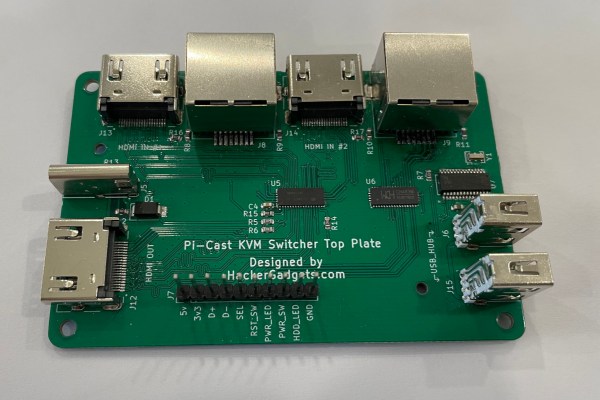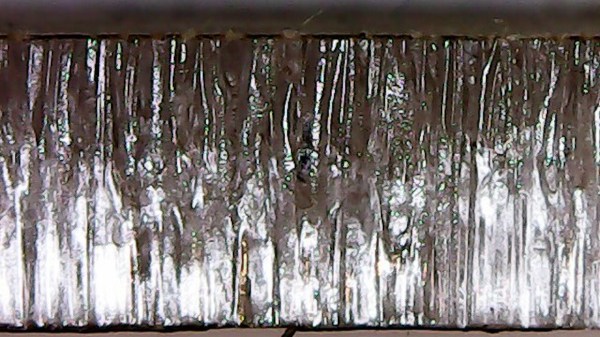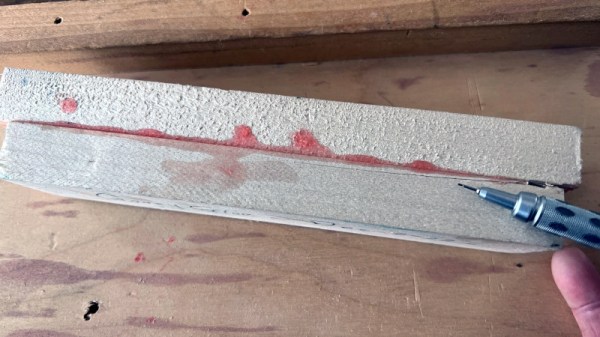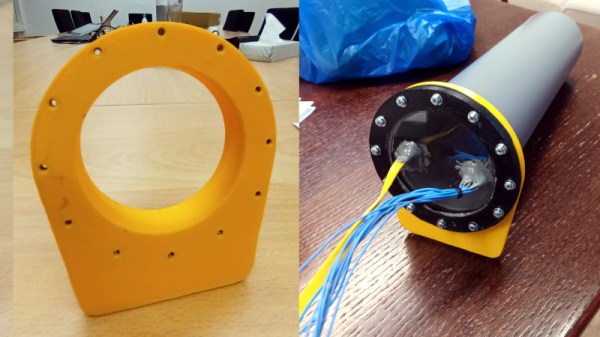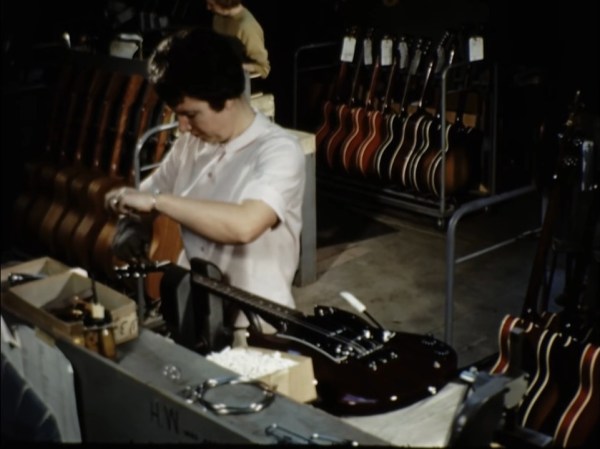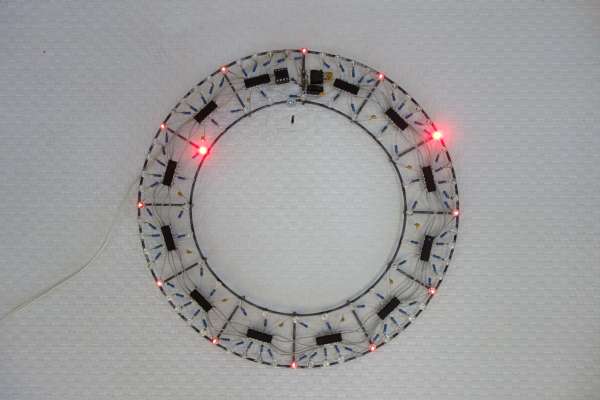A KVM is a great tool for administering a number of different computers without cluttering one’s desk with extra peripherals, or for having to re-connect the keyboard, video, and mouse to each new machine as needed. For local administration this can save a ton of time and headache. For remote administration, though, a virtual KVM is needed, and although these solutions are pricey it’s possible to build one around a Raspberry Pi for a fraction of the cost. This one adds even more functionality by also switching the ATX signals from the motherboard and simplifying cable management to boot. Continue reading “Pi-Cast Adds ATX Signalling To KVM”
Debugging Laser Cut Wobble, The Scientific Way
[PWalsh] was using his lasercutter to cut acrylic, expecting the cuts to have a pleasantly smooth edge. Alas, the edges turned out to be wobbly and sandpaper-like, not smooth in the slightnest. Bummer! Internet suggested a stepper motor swap, but not much in the way of insights – and that would’ve been a royal pain for sure. How would you approach debugging such a problem? Well, [PWalsh] didn’t want to swap crucial components willy-nilly, going the scientific way instead, and breaks it down for us.
Having compiled an extensive list of possible places to look for a fault in, he started going through fundamental assumptions. Do other lasercutters experience this issue? No, even the cheap ones can cut things properly. Is it water level causing intermittent cooling? Nope, not that. Is it the stepping settings? Tweaked, not that. Laser pulsing frequency? No dice. Continue reading “Debugging Laser Cut Wobble, The Scientific Way”
A Nomadic Chair
There’s no shortage of different types of folding or portable chairs, but designer [Jorge Penadés] built a backpack chair that will go the long haul.
Furniture that assembles without screws or glue is always intriguing, and this chair fits the bill. Using simple metal connectors and joinery, it can be setup and taken down in about two minutes without the flimsy feeling of a bag chair. With a natural finish on the wood, the connectors give a nice pop of color without feeling overwhelming. There are even some pictures of a couch version if you follow the link.
In backpack mode, the pieces are held together by leather patches and ratchet straps. [Penadés] was focused on portability over comfort with this piece, but we think this connection method could be used in the future for more comfortable furniture that is still portable.
If you’re looking for more interesting furniture, checkout this Tambour Table with a Puzzling Secret or these CNC-able Seats.
2022 FPV Contest: Turbo Super Submarine
The projects featured on these pages frequently rule the air, the ground, the rails, and even the waves, but very rarely do they rule the deep. Building a submarine is hard, and thus it’s a challenge not taken on by all but the most courageous of builders. This hasn’t discouraged [Timo] though, who has embarked on the construction of what is shaping up to be a very nice underwater ROV build.
The design is straightforward enough, with a PVC tubing frame carrying thrusters for maneuvering, and a central tubular compartment for the electronics and a camera. Control and power comes via a wired connection, and there is a companion controller holding a Pi Pico interfaced to a PlayStation controller.
So far the craft is a work in progress, and he’s engaged in a battle with water pressure to keep in dry inside. The fittings are all 3D printed, and this means a constant battle with warped prints and collapsing infill. He’s not given up though, and is instead recovering enthusiasm by working on the shore-side controller.
We look forward to seeing this project completed, meanwhile if you’re thirsty for more underwater projects take a look at the glider which won the 2017 Hackaday Prize.
Retrotechtacular: Gibson Factory Tour, 1967-Style
If nothing else good came out of 2020, we can say that we at least have “Instrument of the People” — some 1967-era footage of Gibson Guitars’ “craftory”, which was discovered sometime in the fall of 2020. It appears a bit boring at first — a suit slowly approaches the camera on a dimly-lit factory floor and you half-expect an ‘oh, I didn’t see you there’ type of introduction, but no. When he reaches the foreground, he finds a candy apple-red Gibson semi-hollow body guitar waiting for him. After giving the thing a quick once over, he assesses the straightness of the neck and then begins shredding on it, fingerpicking style.
If you like this or any type of guitar music, then hang on to your headstock, because it lilts nonstop throughout this 20-minute tour as we see a parade of nameless, and often headless, players showing their stuff on various styles of Gibson both electric and acoustic.
Continue reading “Retrotechtacular: Gibson Factory Tour, 1967-Style”
Form Follows Function In This Circuit Sculpture Clock
Electronic components are strictly functional objects: their appearance is determined by the function they’re meant to fulfil. But that doesn’t mean there’s no beauty in them. In fact, a whole discipline called circuit sculpture exists that aims to make beautiful shapes out of nothing more than electronic components and wires. Today we can show you [Maarten Tromp]’s latest work in this field: a wall-mounted clock that he’s christened the Clock Sculpture.
The clock’s main structure consists of two concentric rings made from galvanized steel wire, held together by twelve spokes. All components are soldered directly onto those two rings, with no additional mechanical support. Steel isn’t the greatest material for soldering to, but [Maarten] managed to make it work with a high-wattage soldering iron and a bit of plumbers’ flux.
The overall design is simple but clever: the outer ring holds 60 LEDs to indicate the minutes, with every fifth LED always illuminated dimly in order to provide a background reference in dark conditions. There are 24 LEDs on the inner ring to indicate the twelve hours as well as the “half-hours” in between. Without these, the dial would look a bit odd at 30 minutes past the hour.
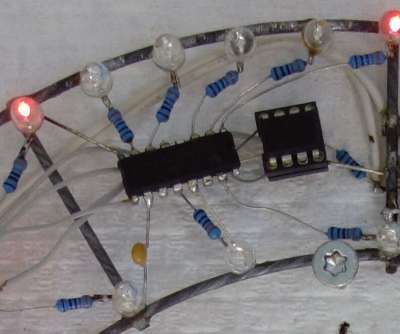 A mains transformer, plus a single diode, a buffer capacitor and a 7805 regulator form a simple DC power supply, with its negative terminal connected to the steel frame. Time is kept by an ATtiny13A that counts mains frequency pulses. There’s no way to adjust the time: you’ll have to plug in the clock exactly at noon or midnight in order to synchronize it with the outside world. A crude method perhaps, but one that fits well with the clock’s bare-bones aesthetic.
A mains transformer, plus a single diode, a buffer capacitor and a 7805 regulator form a simple DC power supply, with its negative terminal connected to the steel frame. Time is kept by an ATtiny13A that counts mains frequency pulses. There’s no way to adjust the time: you’ll have to plug in the clock exactly at noon or midnight in order to synchronize it with the outside world. A crude method perhaps, but one that fits well with the clock’s bare-bones aesthetic.
The individual LEDs are driven by a set of twelve 74HC595 shift registers, all mounted dead-bug style between the two rings. Signals and power are carried between the chips by inconspicuous grey wires taken from old IDE cables; this gives the clock a clean, uncluttered appearance. [Maarten] has had the sculpture clock in his office for several months and while it apparently took some time to get used to, he claims it’s easy to read in bright and dark conditions.
Circuit sculpture has formed the basis for several stunning clock projects: this Tie Fighter-shaped clock for instance, or this insanely complex LED clock. Our 2020 Circuit Sculpture contest yielded many breathtaking designs, too.

